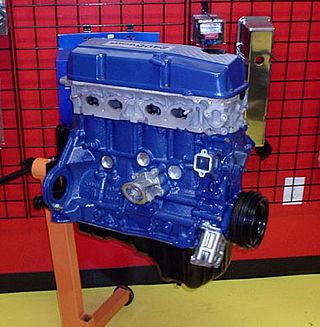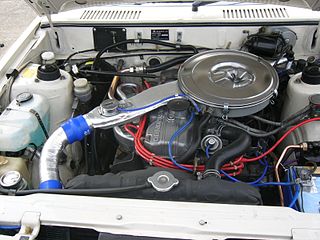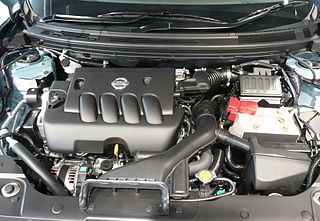
The VK engine is a V8 piston engine from Nissan. It is an aluminum DOHC 4-valve design.

The VQ is a family of V6 automobile petrol engines developed by Nissan and produced in displacements varying from 2.0 L to 4.0 L. Designed to replace the VG series, the all-aluminium 4-valve per cylinder DOHC design debuted with Nissan's EGI/ECCS sequential multi-point fuel injection (MPFI) system. Changes from the VG engine include switching to a timing chain from a timing belt, and relocating the water pump from the outside of the engine to inside the timing cover where the pump is driven by the timing chain. Later versions featured various improvements, such as variable valve timing, and NEO-Di designated VQ engines replace MPFI with direct fuel injection.

The RB engine is an oversquare 2.0–3.0 L straight-6 four-stroke gasoline engine from Nissan, originally produced from 1985 to 2004. The RB followed the 1983 VG-series V6 engines to offer a full, modern range in both straight or V layouts.

The VG engine is a family of V6 engines designed and produced by Nissan between 1983 and 2004.

The QR family of inline-four piston engines by Nissan were introduced in 2000 and range from 2.0 to 2.5 L in displacement. These motors are aluminum, dual overhead camshaft (DOHC), four-valve designs with variable valve timing and optional direct injection. The engine shares much of its architecture with the YD diesel engine.

The SR engine is a series of 1.6 L (1,596 cc), 1.8 L (1,838 cc) or 2.0 L (1,998 cc) straight-four, four-stroke gasoline engines manufactured by Nissan. It has an aluminium head and block with steel sleeves and has a DOHC 4-valve design, with variable valve timing on select models.

The KA engines were a series of four-stroke inline-four gasoline piston engines manufactured by Nissan, which were offered in 2.0 and 2.4 L. The engines blocks were made of cast-iron, while the cylinder heads were made of aluminum.

The Mitsubishi Astron or 4G5/4D5 engine, is a series of straight-four internal combustion engines first built by Mitsubishi Motors in 1972. Engine displacement ranged from 1.8 to 2.6 litres, making it one of the largest four-cylinder engines of its time.

The Mitsubishi Sirius or 4G6/4D6 engine is the name of one of Mitsubishi Motors' four series of inline-four automobile engines, along with Astron, Orion, and Saturn.

The Toyota JZ engine family is a series of inline-6 automobile engines produced by Toyota Motor Corporation. As a replacement for the M-series inline-6 engines, the JZ engines were 24-valve DOHC engines in 2.5- and 3.0-litre versions.

The Renault-Nissan MR engine family consists of straight-four 16-valve all-aluminium and water cooled automobile engines with variable valve timing co-developed by Renault and Nissan. Renault calls it the M engine. Other noteworthy features of this engine family include acoustically equal runner lengths and a tumble control valve for the intake manifold, a "silent" timing chain, mirror finished crankshaft and camshaft journals, and offset cylinder placement in an attempt for increased efficiency.
Variable compression ratio (VCR) is a technology to adjust the compression ratio of an internal combustion engine while the engine is in operation. This is done to increase fuel efficiency while under varying loads. Variable compression engines allow the volume above the piston at top dead centre to be changed. Higher loads require lower ratios to increase power, while lower loads need higher ratios to increase efficiency, i.e. to lower fuel consumption. For automotive use this needs to be done as the engine is running in response to the load and driving demands. The 2019 Infiniti QX50 is the first commercially available vehicle that uses a variable compression ratio engine.

The L-series is a compact inline-four engine created by Honda, introduced in 2001 with the Honda Fit. It has 1.2 L (1,198 cc), 1.3 L (1,318 cc) and 1.5 litres (1,497 cc) displacement variants, which utilize the names L12A, L13A and L15A. Depending on the region, these engines are sold throughout the world in the 5-door Honda Brio Fit/Jazz hatchback Honda Civic and the 4-door Fit Aria/City sedan. They can also be found in the Japanese-only Airwave wagon and Mobilio MPV.

The MA is a straight-4 SOHC 0.9 L, 1.0 L, or 1.2 L engine first introduced in 1982 by Nissan, intended primarily for the K10 series Micra/March model. It shares design similarities with the older E engine, with an 8-valve hemispherical cylinder head but differs in that it uses an aluminium cylinder block. Unusually, the specified ignition timing for the MA10 running on the specified 90 RON gasoline was 2 degrees after top dead centre, reflecting a very high flame speed in the compact combustion chambers.

The Infiniti QX50, previously the Infiniti EX or Nissan Skyline Crossover until 2013, is a compact luxury crossover SUV produced by Infiniti, the luxury vehicle division of Japanese automaker Nissan. The first-generation QX50 is a minor model update of the EX, while also changing the nameplate to QX50 in line with the marque's new Q and QX nomenclature, which took place for the 2013 (China) and 2015 model years. The second-generation QX50 entered production in November 2017 as a 2019 model.

The E0 series is a three-cylinder gasoline engine developed and manufactured by Honda, with a total displacement of 656 cc. The engine is intended for kei car applications. The E05A and E07A were partially replaced by the Honda P engine but as of 2020 the E07Z engine still saw use in the Acty truck.

The Nissan VRH engine family consists of several racing engines built by Nissan Motor Company beginning in the late 1980s. All VRH engines are in a V8 configuration, with either natural aspiration or forced induction. Some VRH engines are loosely based on Nissan's production V8 engine blocks, including the VH and VK engines, while others were designed from the ground up for racing and share no components with production blocks.
The Suzuki R engine is an inline-three engine that has been produced by Suzuki since 2011. Initially introduced in the third-generation MR Wagon, and intended as a replacement for the K6A engine, the R engine has since been used in various Suzuki's, such as the Alto, the Wagon R, and the Carry.

The Hyundai Smartstream is a gasoline and diesel automobile engine branding used by Hyundai since 2018. An all-aluminum engine of Hyundai Motor Company debuted in the third-generation Hyundai i30 hatchback, which was unveiled in 2018 at the Paris Motor Show.

The Suzuki K engine family is a series of automobile engines from Suzuki, introduced in 1994. Displacements range from 0.7 L to 1.5 L. All engines have aluminium cylinder blocks with three or four cylinders in-line. Cylinder heads have two overhead camshafts, driven by chain, and four valves per cylinder. Fuel is gasoline/petrol, metered by multipoint fuel injection or direct injection. Some variants are turbocharged.


















